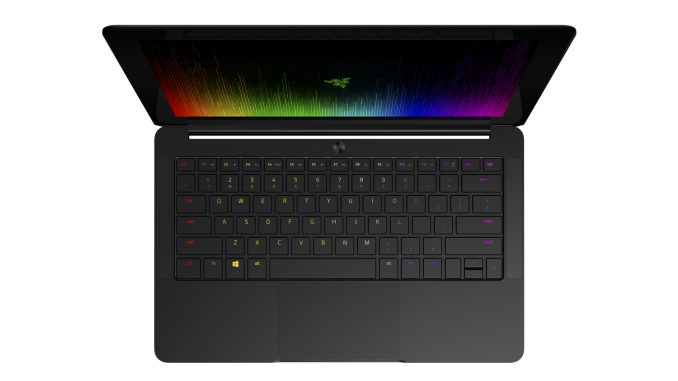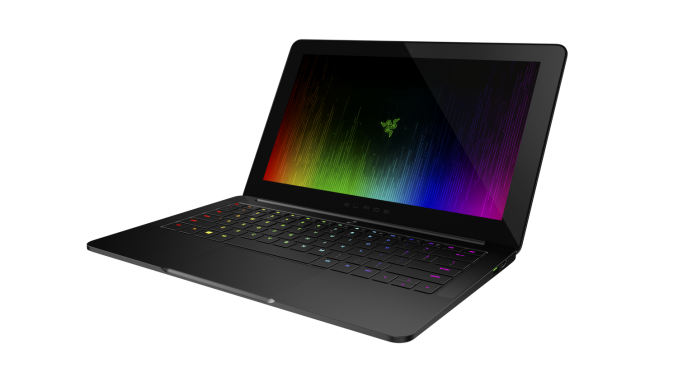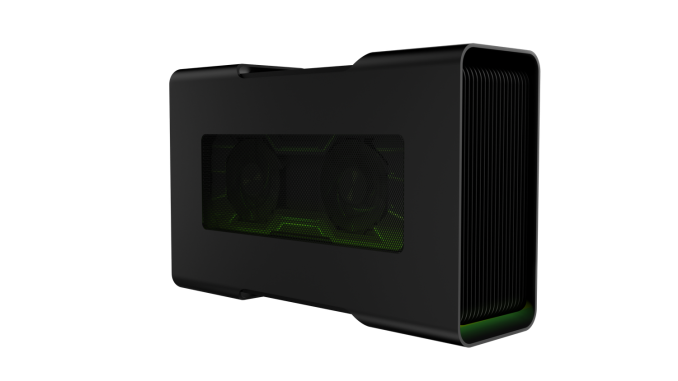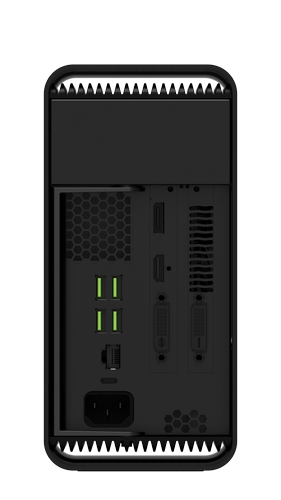Razer Launches The Razer Blade Stealth Ultrabook And Razer Core At CES 2016
by Brett Howse on January 6, 2016 9:01 AM EST- Posted in
- Laptops
- Razer
- Trade Shows
- CES 2016
- Razer Blade Stealth

Today we have some news that is kind of unexpected. Razer, the company known for gaming peripherals and gaming laptops such as the Razer Blade, has decided to enter the Ultrabook market with the launch of the Razer Blade Stealth. Not only is an Ultrabook not something expected from Razer, it is also priced very competitively and undercuts the competition on price.
Razer did not cut any corners either when designing the Stealth. Just like it’s more powerful and higher priced siblings, it is built out of a CNC-milled aluminum chassis, which is a designing feature of Razer laptops. But despite the solid frame, the laptop is still only 0.52-inches thick and weighs in at just 2.75 lbs. On the styling front, it keeps the black finish of other Razer laptops, but also outdoes them with a full “Chroma” keyboard with individually lit RGB keys. I’ve been hoping that they would do this for a while when reviewing the Razer Blade, so it’s great to see the RGB keyboard come to the Stealth model.
The 12.5-inch display comes in two options. The base model is a QHD (2560x1440) resolution, but you can also opt for a UHD (3840x2160) model with full Adobe RGB color gamut. I need to check in with Razer on how they are going to handle the wider color gamut, and will let you know after we get some hands-on time on the show floor.
The Stealth, as an Ultrabook, is going to be powered by Ultrabook class components, which in this case is the Intel Core i7-6500U processor. This Skylake chip features two cores, hyperthreading, and a base/turbo frequency of 2.5 GHz / 3.1 GHz. I was hoping that Razer would also offer a model with Intel’s Iris GPU, but that won’t be the case, at least at launch. The only memory option is 8 GB of LPDDR3-1866, and storage options range from 128 GB to 256 GB of PCIe storage on the QHD model, and 256 GB to 512 GB on the UHD model. The battery life will need to be tested, but the laptop has a 45 Wh battery, so it’s not going to be class leading in that regard.
For connectivity, the Stealth will have two USB 3.0 ports, and a USB 3.1 Type-C connector with Thunderbolt 3 support. The Thunderbolt is a key component to the Stealth, thanks to the accessory that Razer is also launching.
The Razer Core is a Thunderbolt 3 connected external GPU, which also acts as a docking station for the Stealth. With a single cable connection, the laptop can power an external display, all of the docking connections with four USB 3.0 ports and Gigabit Ethernet, and support for a 375W GPU.
The Core features a built-in 500W power supply, and the GPU support is for any single card which is full-length and double-wide, which means pretty much any GPU out there. The Core also features two additional Chroma lighting zones so that you can tailor it to your liking.
Razer has not yet announced any updates to the Razer Blade or Razer Blade Pro, but I would expect that both of these will also feature support for the Core when they do get their next refresh.
The Core supports plug and play with validated graphics cards, without the need to reboot.
The addition of the Razer Core brings back some of the gaming performance that Razer has been known for, although with a U series CPU it will be interesting to see what level of GPU is required to become CPU bound, especially with DX 12. If we can track down a review unit, we’ll try to sort that out.
The Razer Blade Stealth will be on-sale starting today, with a starting price of just $999. Considering the high resolution panel and Core i7, this undercuts most, if not all, of the Ultrabook competition on price. The top end 4K model with the UHD display and 512 GB of storage will be $1599.
Source: Razer















84 Comments
View All Comments
ImSpartacus - Wednesday, January 6, 2016 - link
Dynamically jumping from 15W to 45W provides a decent about of heat. How do you dissipate that much heat from a scrawny laptop chassis?Alexvrb - Wednesday, January 6, 2016 - link
He's saying take a 45W mobile quad core, and when on battery power turn off two of the cores and drop voltage + clocks on the remaining two. That may not even be possible to do dynamically. So really heat isn't your primary impediment in this case. A slightly different chassis design and a special dock designed to force more air would do the trick.DanNeely - Thursday, January 7, 2016 - link
Dynamic frequency/voltage scaling already based on battery/wall power is an option so at least half of it is doable. I don't know if changing the number of available cores is possible via a driver or would need OS changes to implement. If the latter a hardware level fudge might still be possible with the low power state being dual core and hyperthreaded, and the high power on quadcore non-HT. To the OS the chip would always have 4 cores; the performance gap on battery would just be larger than the clock reduction would indicate. Do Arm's big/little core setups need OS support for changing the core config, or is the magic all done in drivers/firmware? If the former, adding it to desktop Windows probably would be strait forward even if it's currently compile flagged for W10 mobile at present.TheinsanegamerN - Thursday, January 7, 2016 - link
When in 45 watt mode, you don't magically get a bigger chassis. To handle the kind of heat, you need more heat sink space. Airflow can only do so much.ImSpartacus - Wednesday, January 6, 2016 - link
That's not entirely correct.You can pick up an asus ux305 ultrabook for $700 ($600 sales are common) with 8gb ram and a 256gb ssd. Then you can build an admirable 1440p60 gaming desktop for $800-$1200. There are decent 1440p monitors out there for $300 (or less). Decent peripherals and an OS are perhaps another $200 (or less).
That's something like $1900-2400 assuming you can't poach any free parts.
With the Stealth and Core, you're looking at $1600 for the laptop (you need the extra storage if it's your only machine). Then an estimated $200-$500 for Core. Then at least $300 for a 1440p-worthy gpu.
That's $2100-$2500 without an external monitor (yay, gaming on a 12.5" screen!) or any peripherals (mouse?!).
I think they are close and there certainly nice features the Stealth that might be attractive (touch screen, chroma keyboard, etc). However, it's not a clear victory for the Stealth+Core.
MadDuffy - Wednesday, January 6, 2016 - link
(wishing AT would let me edit comments)Previous AT coverage:
MSI had a working prototype of an external GPU box in 2012: http://www.anandtech.com/show/5352/msis-gus-ii-ext...
DIY eGPU coverage from 2014:
http://www.anandtech.com/show/7987/running-an-nvid...
Alienware's implementation from a year ago is very similar to the Razer Core but uses a proprietary connector, I doubt very much it sold well but it was 300 USD:
http://www.anandtech.com/show/8653/alienware-graph...
DanNeely - Wednesday, January 6, 2016 - link
At that price it probably didn't sell well; but if I could only have a single computer the Alienware 13 + external GPU would probably be my choice over a traditional high end gaming laptop because the AW 13 is a reasonable option for a carry around laptop as opposed to something that was only used on a desk and lugged to lan parties like traditional gaming laptops.jasonelmore - Wednesday, January 6, 2016 - link
the reason it did not sell well was because it used a proprietary connector.. This razer core will sell well so long as it's compatible with all laptops with thunderbolt 3.eldakka - Thursday, January 7, 2016 - link
MSI have a G30 and gaming dock.I don't know the price of the dock separately, but an <a href="http://affordablelaptops.com.au/contents/en-us/p27... site</a> offers a package deal with laptop (13.3" 1080p, 16GB, i7-4870HQ, Iris Pro 5200, 2x128GB M.2 SSD) and dock (PCIE3 x16, 3.5"SATA, USB3, Killer Gb LAN, speakers/woofer) with GTX980 dGPU for AU$3350 (US$2350).
It is a model that's been out awhile (i7-4870HQ), but maybe there's an upgraded version in the works?
Price seems quite good including a GTX980, but of course, buying the dGPU from the laptop seller (AU$799 in this case) is more expensive than buying your own card separately.
tipoo - Wednesday, January 6, 2016 - link
I thought there was some news of them being less draconian about licencing for 3, which was why there was hope for Thunderboxes?